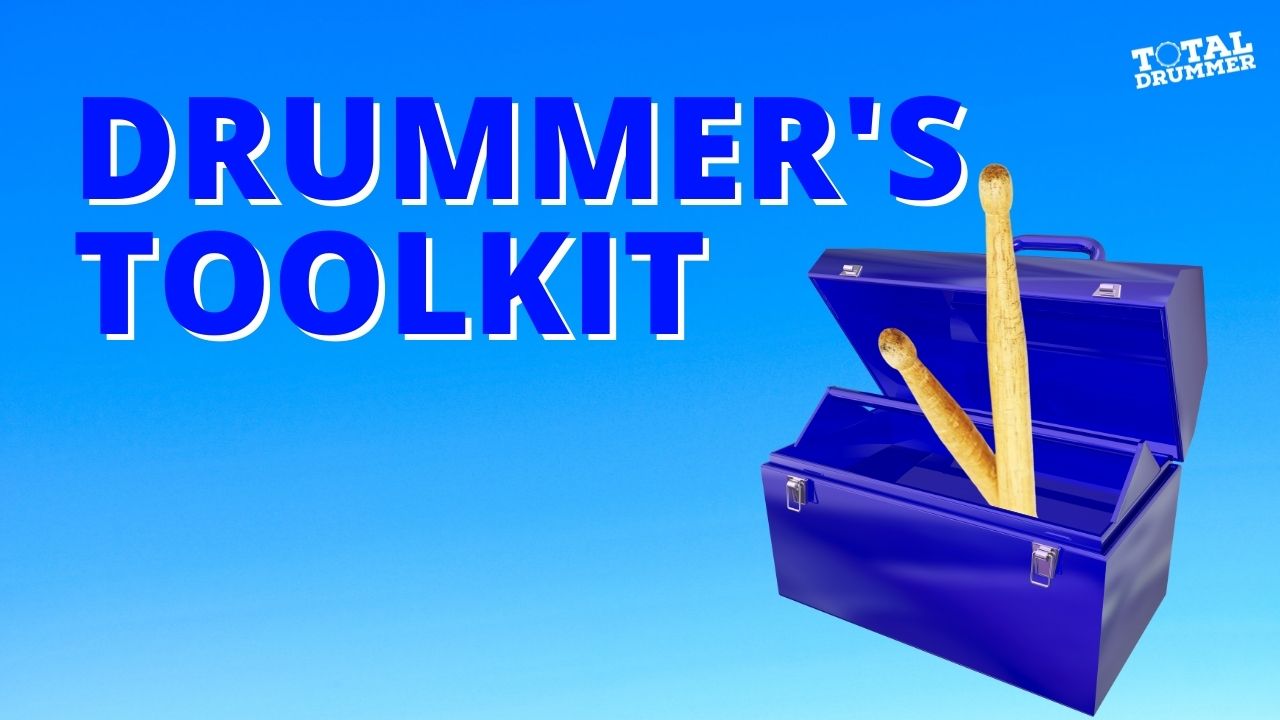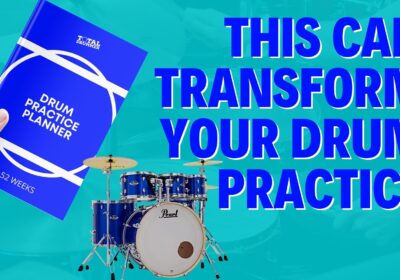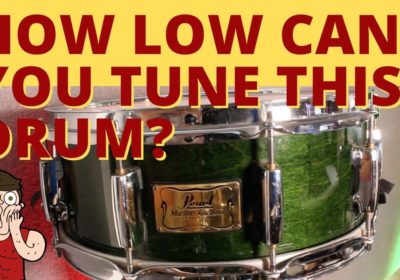How to Choose a Drum Kit -Which Drum Set Should You Buy?
A guide to help you choose a drum kit
This Is The Drum Kit Buying Guide
This drum kit guide is here to help you start your journey and choose a drum kit. There are so many options out there today that it can be overwhelming. This drum kit guide should help to answer those important questions when buying your first drum kit.
Acoustic or electronic?
Second hand or new?
Often a drummer will start his or her drumming life with just a pair of sticks and a practice pad. This, coupled with decent drum lessons, enables them to attain the necessary rudimental techniques that are crucial in order to play the drums.
Once they reach a point where they know they want to continue drumming as a long term hobby, it is time to make that next important step – CHOOSE A DRUM KIT.
This is not something to rush into as it is expensive, noisy and very large so the practical implications are that your neighbours may now hate you, you’ll be skint and you’ll have to get rid of the 50” TV to make room for it.
Once you’ve come to terms with these aspects you walk into your music shop or type ‘drum kit’ into a search engine and are instantly hit with so many options that it’s overwhelming.
But fear not, this drum kit guide will hopefully help you quickly sift through the mass of drums on offer and allow you to choose the drum kit which you will love, buy it and get practising in no time at all.
New or second hand?
New
Some people just like buying things new, safe in the knowledge that no other drummer has hit, sweated on, bled on, or dribbled on their lovely newly acquired instrument. This is fine and there are many kits on the market today for around the £200 mark and rising into the thousands.
Often the budget kits have fewer tension rods around the kit (so fine tuning is less accurate), have thinner shells, use cheaper wood, have less glamorous finishes and have weaker hardware than the higher end kits. This does not always mean they are bad, but simply that you get what you pay for and these are some of the comprimises made to be able to offer them at cheaper prices.
However, features that were previously reserved for higher end kits are increasingly been found in budget kits. These are excellent choices for beginner drummers and will offer adequate sound and quality for several years with a little knowledge when selecting the kit. Manufacturers have appreciated the size of this part of the market and have stepped up to offer some great kits.
The one area that will soon emerge as substandard is that of the cymbals. Whereas the drums can be treated to new, better quality drum skins and consequently enjoy a better sound, the cymbals are what they are. Not only do they sound worse than hitting a saucepan lid, they are also very flimsy and the hi-hats will often invert following a sturdy hit by a beginner drummer who lacks the finesse and technique of an experienced player.
Pros
- New kits should be in pristine condition
- If something goes wrong with it you can take it back to the shop and they will sort the problem out
- It will benefit from the most up-to-date technology and trends.
Cons
- It will cost more than a second hand kit
- It may not include all the necessary parts (cymbals, stool, hardware, pedals), therefore they will need to be bought separately
- If cymbals are included in the package, they may be terrible
 Where to buy from
Where to buy from
There are so many online options today that many people are going down this route. This can be great for the consumer as we can easily find the best price. The downside is that the local music shop may be suffering through lost sales (although the ones on the ball also provide a thriving online business as well). I have bought many drum items online and have not yet had a problem but then I also know what to look for. Here is the biggest selection of online Drum Kits.
Whenever I’m buying a product for something that I’m new to, I really appreciate walking into a shop and talking to the sales person who is willing to share their expertise. They can help point you to the right product, let you know what else you’ll need, and often offer a service to build and tune the kit. Furthermore, if a part is missing or damaged, you know where the shop is and you can take it back for the shop to sort out. This is not always possible when bought by a faceless retailer on the Internet.
Second Hand
Second hand options are well worth considering when you choose a drum kit. If a drum kit has been treated well, the only part that should show any wear is the drum head of each drum. This is the part that is hit by the stick and is easily replaceable. In fact, they should be replaced from time to time so don’t be put off if the heads look old and beaten, focus on the shells and hardware.
Deep knowledge of drum kits is not really necessary here. Just examine the general state of the equipment. Are the wooden shells in good condition or chipped and dented? Is the metal hardware pitted and rusty or shiny and pristine? Was the kit stored in a warm and dry or cold and damp environment?
Bearing Edge
An important part of the shell is the bearing edge. This is the angled tip around the circumference of the shell (top and bottom) which makes contact with the drum head, and it has a huge impact on the sound. Each bearing edge should be free from chips or dents as they will adversely affect the sound. If the drum has clear heads, you will be able to check the condition of the bearing edges but ideally you would take off each head and run your finger around it to feel how smooth it is.
Pros
- Get more for your money
- The kit should be complete and may even include extras
- The cymbals may have been upgraded.
Cons
- Someone else has used it and it may show wear
- It may not perfectly fit the description if bought online
Where to buy from
- The local paper used to be a great place to start but in recent years that has been eclipsed by the use of online options.
- Facebook Marketplace can be a useful resource for locally sold instruments.
- Amazon is a vast marketplace to buy pretty much anything including drum kits.
- Other less specific sites such as www.gumtree.com include listings for musical instruments.
- But the most well known and well used option is www.ebay.com
Online warnings – We are all familiar with the likes of Ebay as the modern preference for buying and selling second hand and new items online. These are excellent in many ways but it is worth being aware of a couple of points when buying drums.
1. Not many people want to post a drum kit so only look at items that you can travel to pick up.
2. It is not always easy to see the condition of the kit in photos. If possible, ask if you can view the kit before buying.
3. If the kit falls apart after two weeks, you will find compensation harder to come by than if bought from a shop.
Beyond the online options, put the word about and you never know who will know someone that has an old unwanted kit lying around. Ask the local drum teacher as they are bound to have students that are upgrading and needing to sell their old kit. Ask the local music shop as they will often deal in used gear.
VERDICT
Second hand would be my preference for a first kit. You will get more for your money if you seek the right deal. You can change the heads and it will look like new if it’s been cared for. The kit should be complete if another drummer has been playing it, and may even benefit from better cymbals and various accessories such as tutorial books, sticks, add-on cymbals, etc.
Acoustic or electronic?
ACOUSTIC
This is what drumming is all about. The raw primal attraction to this instrument stems from the large, noisy acoustic drum kit that taps into some kind of primeval instinct. In modern day applications these kits also allow us to let off some steam after a stressful day at school or the office.
The most standard configuration that you will find is the 5-piece kit. This means that there are five drums (bass drum, snare drum, two rack/hanging toms (fixed atop the bass drum), and a floor tom). Along with this you will need a stool, bass drum pedal, cymbals, cymbal stands and sticks.
The most common sizes are the ROCK and FUSION sizes. Rock kits consist of a 22” diameter bass drum, 12” and 13” rack toms, a 16” floor tom, and a 14” snare drum. Fusion kits consist of a 20” bass drum, 10″ and 12” rack toms, a 14” floor tom, and a 14” snare drum. There is no wrong or right here, and at the beginner stage it is hardly relevant. It’s worth noting that there are also junior kits for the younger player. These are great if the drummer wants to start aged 5 or 6 or similar. Just be aware that as they grow they will outgrow this kit so make that decision based on their size and how long you think the kit will last them.
My opinion is that the fusion sizes are more versatile, able to be tuned low for rock applications and tuned higher for a tighter funk/fusion sound, and even able to get away with a slightly more authentic jazz or Latin sound if desired than the rock kit offers. The rock sizes are less versatile and really only suited to the bigger rock sounds.
A last word here if you think these are too noisy but you are not enamoured with the electronic options; you can buy Drum Kit Silencer Practice Pads which sit on top of the acoustic drum and reduce the sound to much more acceptable levels. This way you can practice quietly and still have the real acoustic drum kit for when you need to pump it out at full volume!
Pros
- Possible to sound good when well tuned at a lower purchasing price
- These are the real deal – pure unadulterated thunderous drum sounds
- Will be suitable when you get out gigging with a band
Cons
- They are noisy
- They are big
What to look out for
- Does it include all necessary cymbals/stands/stool/pedals/sticks?
- Is the build quality good (look at drum shells, fittings, hardware)?
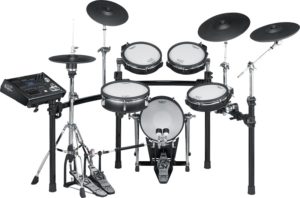 ELECTRONIC
ELECTRONIC
Electronic drum make up a huge part of the drumming market today, and many retailers state these to be their best sellers. As technology improves, these are continually getting better in terms of playability and sounds and the range of quality is huge.
The lower end of the market does have its pitfalls with many products displaying very poor build quality that just isn’t up to the job. Another important consideration is the quality of sounds. The budget kits sometimes offer sounds that are incredibly uninspiring and will soon become passé once the novelty wears off. The third consideration is the feel of the pads. They have come on in leaps and bounds over the last ten years but there is still a massive difference in feel from the top end Roland or Yamaha pads to the budget kit rubber and plastic offerings that are hard and unforgiving. Most beginners that I know to start with a budget electronic kit are desperate for an acoustic kit within a year or two.
Of course sometimes acoustic kits are simply not an option due to their size and noise. In this case an electronic kit is a great option to give the drummer something to practice on. At that point, the more money you can spend, the greater the sound options and quality of sounds/build.
The fact that you get numerous preset kits in the electronic modules means that you can shift between rock, jazz, electro, funk, and many more at the press of a button. Many of the kits also allow the user to plug into a DAW (Digital Audio Workstation (computer music recording software)) which allows for incredibly easy recording of your drum beats. This is a lot of fun and a great learning tool. On the learning aspects, in built metronomes and aux-in connections for connecting MP3 players are a huge benefit.
Pros
- With headphones they are nearly silent
- Easy to hook up with computer recording software and record drum tracks
- Many different sound options from one kit
- In built metronomes and aux in for play along to iPods and the like.
Cons
- The budget kits have limited sounds
- The budget kits are often poorly built
- They lack the earthy excitement of ‘real’ drums
What to look out for
- Build quality
- Pad response
- Number and quality of sounds
- Connection options to play music through them, as well as connecting them to computers.
VERDICT
This depends on the practicalities. If noise and space are not an issue, I would always choose acoustic over electronic. The nuances of sound and earthy connection with the instrument give so much more pleasure than a synthetic representation of this instrument.
However, for many people this is just not an option and with the increasing quality and affordability of electronic kits, they are certainly a fun option and do allow you to take your drumming to a very high level. If it means you get to have a kit at home to practice on, then it is a great option.
I hope this drum kit guide was useful and has helped you understand the considerations for the main kit options out there when you come to choose a drum kit. Have fun finding your first or next drum set – exciting times!
To read which drum kit you should buy for kids read this.
And now you’re getting serious about drumming, you may want to browse the other lessons available at Total Drummer. Check out the free lessons, single lessons, mini courses and main courses, as well as the drum less playalongs and the charts of famous songs.
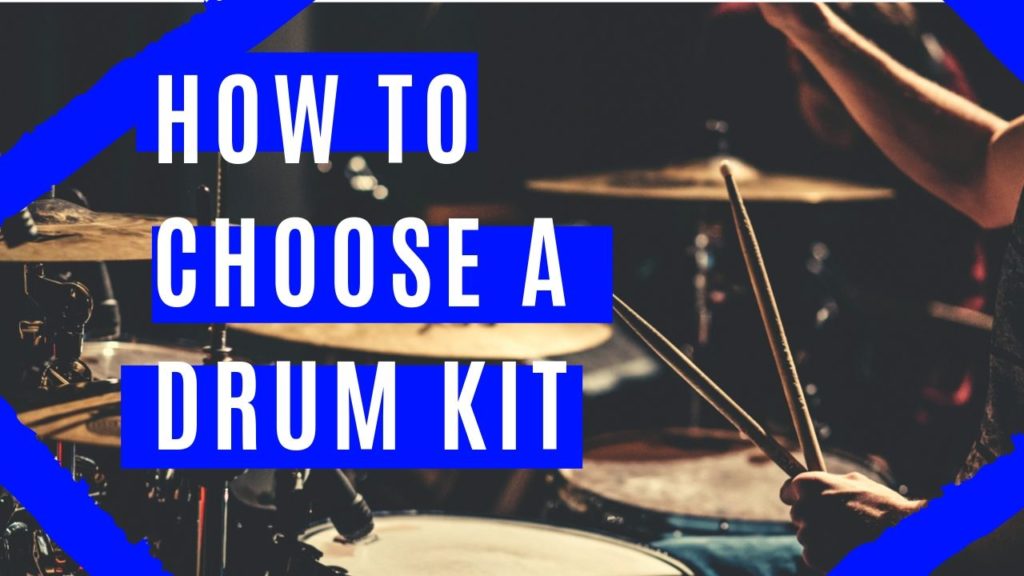
Pssst ......Grab Your FREE Drummer's Toolkit Below
The drummer’s toolkit is a FREE resource that is packed with lessons, courses, transcriptions, drumless tracks and more to help you become a better drummer. It’s free and you’re a couple of clicks away from getting instant access.
Once inside you will:
- Learn How to Play Your First Drum Beat… in 10 Minutes!
- Learn some quick beginner drum fills
- Learn the right way to practice drums
- And learn how to measure your progress from practice
- Access a mini timing course (and learn both types of timing)
- Go through a 7 day faster hands course which will increase your hand speed
- 21 essential stick bag items
- Access the drumless Backing Track Library
- Grab full drum notation for a bunch of famous songs
- …and more!


